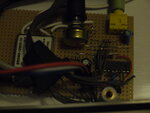polo-g40
Full Member level 2
Daft question? Can mount multple PIC's soldered directly on top of each other with just separate the MCLR's lines turning on one chip at a time under some other control?? I wonder has anybody tried it???
The project I am thinking of (an LED Display) takes some shoe-horning of coding and would be easier adding multiple processing units and having one to "select" the active chip..! It would be Just as easier or easier than adding memory EEProm to add another 16f88. It would make an easy selection process (using a switch to start), but would one chip's output be interefered with by any of the "off" units...? I am using a 16pin 2port chip, and using RA0 & 1 and RB0 to 3 (All drive low, portB drives high too)...
I am likely to give it a go in one form or another unless anyone has tried it, wether it be a separate bit of veroboard or tagged on top of each other, but has anybody tried?? I could try keeping a processor to keep Low-Voltage-Programming a single PIC but that seems a bit ambitious!
Only a hobbiest, but fun!
Kind regards
NEAL
The project I am thinking of (an LED Display) takes some shoe-horning of coding and would be easier adding multiple processing units and having one to "select" the active chip..! It would be Just as easier or easier than adding memory EEProm to add another 16f88. It would make an easy selection process (using a switch to start), but would one chip's output be interefered with by any of the "off" units...? I am using a 16pin 2port chip, and using RA0 & 1 and RB0 to 3 (All drive low, portB drives high too)...
I am likely to give it a go in one form or another unless anyone has tried it, wether it be a separate bit of veroboard or tagged on top of each other, but has anybody tried?? I could try keeping a processor to keep Low-Voltage-Programming a single PIC but that seems a bit ambitious!
Only a hobbiest, but fun!
Kind regards
NEAL
